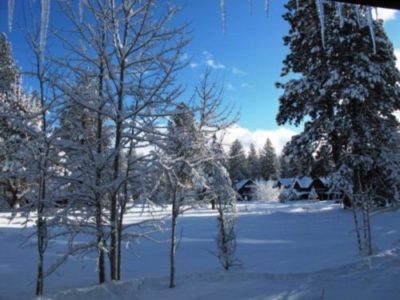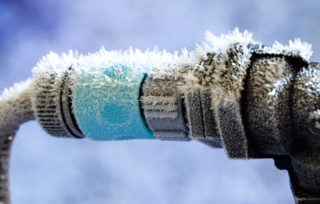Winterizing Your Home
Tips for Winterizing Your Mountain Home
On the heels of last year's winter the task of winterizing your home should be at the forefront of your to-do list over the next month. Much of the damage that was taken on earlier this year due to record levels  of snowfall and the bills paid in order to repair those damages could have been avoided if the proper precautions would have been taken in preparing for what is always an unpredictable winter season here in Tahoe.
of snowfall and the bills paid in order to repair those damages could have been avoided if the proper precautions would have been taken in preparing for what is always an unpredictable winter season here in Tahoe.
Below, we discuss a number of basic concepts to home winterization which, if done properly and in advance, can save you considerable amounts of money in repair costs. As always, we preface all suggestions made below by recommending that professionals be contacted in seeking advice on the best approaches to winterizing your home this season. Enjoy!
Plumbing
The most vulnerable component of a home during the cold winter months is undoubtedly its plumbing system. It is also the most expensive to repair. Let's look at two steps you can take to effectively safeguard your plumbing against freezing temperatures and the burst pipes which result from them.
- Insulate Your Exposed Pipes
Any and all exposed pipes located in uninsulated areas of the home such as a crawl space or attic should be insulated properly. Ideally you apply a initial layer of wrap using heated electrical tape, then insulate with foam on top.
- Seasonal Shut-off
If you know that your property will by uninhabited for several months over the course of the winter you should definitely shut off the water supply and drain the entire plumbing system. If a pipe were to burst and then leak for a continual period of time your property damage could be beyond repair. Watch this short video on proper plumbing system drainage and protect your home this winter.
- Avoid Freezing of Pipes
By turning off your water in the event of you leaving town for any more than a few days you will help to safeguard against the freezing of your pipes. This can be done simply by turning off your home's water valve. Once the supply is properly shut off you should then turn on all faucets and flush all toilets to fully drain excess water from the tank and lines. Lastly, set the thermostat to 55 degrees, this being the recommended safe zone for full prevention.
Test Heating System
- Perform a Test Run
Turn your thermostat on heat mode and set it to 80 degrees. Listen for the furnace to turn on and make sure that warm air is coming out through the registers (this should only take a matter of minutes). If the thermostat is running properly you may switch it back to its normal setting. If not, the next step would be to contact an HVAC specialist for on-site diagnosis.
- Annual Service
To ensure that your thermostat is running efficiently and maintains its quality over a long period of time, we recommend having it serviced annually by a HVAC specialist.
- Replace the Air Filter
This should be done every 3 months and is very easy to do. See video tutorial here.
- Heating Vents
In the interest of healthy air flow and overall quality of air entering your home, remove the heat registers and look inside each vent checking for accumulative dirt and debris. The cleaner the ducts, the easier you and your family will breath. You should contact a trained HVAC specialist to determine whether or not your ducts need cleaning.
Chimney and Fireplace Maintenance
Your chimney and fireplace should be cleaned once every year.  A hired chimney sweep can check for any unwanted build-up in your chimney such as birds nests, squirrels, or any other undesirable critters. The flue damper should be checked to see that it opens and shuts fully. You should also determine that the chimney will draw up the fire and smoke properly. You can test this by rolling up several pieces of newspaper. Then with the fireplace damper open, light the newspaper inside the fireplace. The smoke should rise up the chimney. If it doesn’t, you clearly have an obstruction and need to contact a professional to schedule a chimney cleaning. Check out this informative video provided by Home Depot for a full breakdown on how to winterize your fireplace and chimney.
A hired chimney sweep can check for any unwanted build-up in your chimney such as birds nests, squirrels, or any other undesirable critters. The flue damper should be checked to see that it opens and shuts fully. You should also determine that the chimney will draw up the fire and smoke properly. You can test this by rolling up several pieces of newspaper. Then with the fireplace damper open, light the newspaper inside the fireplace. The smoke should rise up the chimney. If it doesn’t, you clearly have an obstruction and need to contact a professional to schedule a chimney cleaning. Check out this informative video provided by Home Depot for a full breakdown on how to winterize your fireplace and chimney.
Doors and Windows
If you want to see a significant decrease in your home heating bills, start by preventing cold air from infiltrating your home. This issue can be resolved by upgrading your home's windows and doors to newer, more energy-efficient models, thus lowering your utility costs over the long term. If you do not want to commit to the costly upgrades, try weatherstripping instead. Caulking can deteriorate over time and should be inspected to ensure it is in optimal condition. If not, replace it and you will see a substantial difference in your heating costs.
Roof Repair
Schedule a roof inspection to be performed by a professional after carrying out an inspection of your own. You should check for any missing shingles, shakes, or damaged materials. An inspection done by a professional will not break your bank so contact one today in order to catch leaks early, thus saving you the money on what could be an untimely full roof replacement.
Disconnecting Hoses/Irrigation Line Drainage
Newer homes in our area generally come equipped with "freeze proof" water spigots, in which case owners would simply disconnect hoses from the spigots to prevent freezing and damage to the hoses. Older model homes, however, without these built-in safeguards require that additional steps be taken. We recommend contacting a local plumber for advice on this matter.
Irrigation lines will need to be drained.  Air pressure is used to carry out this procedure which insures that water does not collect in lines, freeze, and then rupture, all leading to costly repairs. Again, we suggest contacting a local landscaper to discuss this procedure. You can also click here for another informative video, this time describing the "whys" and "hows" surrounding the imperative nature of draining your home's irrigation lines.
Air pressure is used to carry out this procedure which insures that water does not collect in lines, freeze, and then rupture, all leading to costly repairs. Again, we suggest contacting a local landscaper to discuss this procedure. You can also click here for another informative video, this time describing the "whys" and "hows" surrounding the imperative nature of draining your home's irrigation lines.
Home Insurance Policy
If there is one season that brings with it the highest potential for incurring damage to your home, it is winter (at least for homeowners in the Tahoe Basin). What better time of the year, then, to review and renegotiate, if necessary, your home insurance policy? Having the appropriate amount of coverage helps to insure your investment and provides peace of mind. Contact your agent today!
Additional Suggestions
- Have plenty of candles, matches, flashlights, and batteries for them on hand in case electricity goes out.
- Purchase a snow blower for your driveway/walkways and a smaller one for your deck if applicable. If you already own these mechanical life savers, have them serviced. These machines being at-the-ready will save you and, more specifically, your back from the perils of what may seem, at times, like a relentless amount of shoveling.
- Arrange with a neighbor to check on your home if you know you will be away from it for an extended period of time.
- Restock wood supply.
- Set up your snow removal plan with one of the local companies.
- Have non-perishable food supply stocked in case of extended power outages.
Thank you for reading and feel free to contact us here to further discuss winterizing your property, for contractor referrals, or for any tips/information which might help to make your winter in Tahoe safer and more enjoyable! We're always here.
